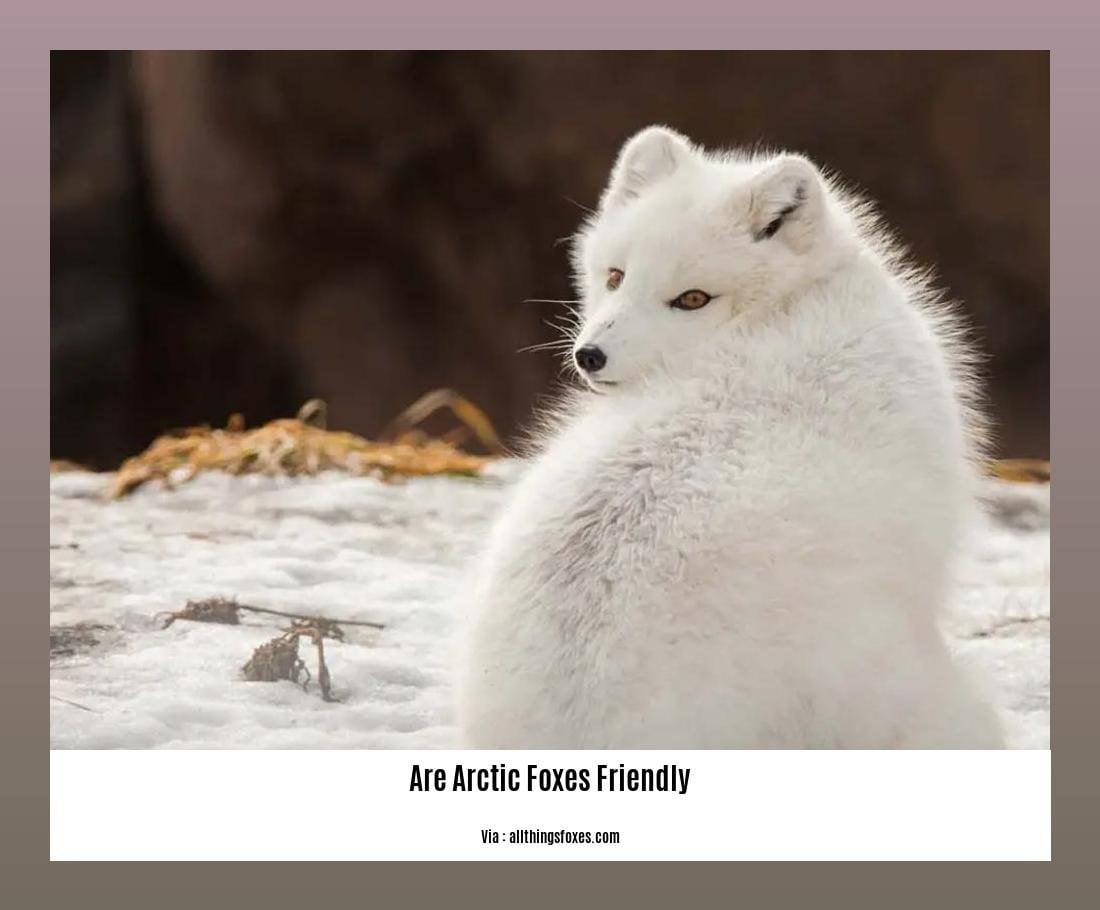Are Arctic Foxes Friendly? Unveiling the Truth About Their Behavior towards Humans
Exploring the fascinating dynamics between Arctic foxes and humans, this article delves into the question of whether these captivating creatures exhibit friendly traits towards people. As members of the canidae family, Arctic foxes are renowned for their unique hunting style and remarkable adaptations to the harsh Arctic environment. With females giving birth in the spring, their behavior towards humans remains a captivating mystery that we aim to uncover.
Key Takeaways:
- Arctic foxes are generally friendly towards humans but may attack if they feel threatened.
- It is advisable to maintain a distance of several hundred meters from arctic foxes.
- Keeping arctic foxes as pets is not recommended due to their wild nature and potential for danger.
- Arctic foxes, also known as white or polar foxes, are native to the Arctic regions of the Northern Hemisphere.
- They have adapted to survive in cold environments and exhibit scavenger-like behavior in order to thrive in the tundra.
- Arctic foxes are relatively small, with an average length of 46 to 68 cm and a weight ranging from 2.5 to 9.4 kg.
- They inhabit the northernmost regions of the world, particularly in the Arctic tundra biome.
- It is important to respect the status of arctic foxes as wild animals and maintain distance for the safety of both humans and foxes.
Are Arctic Foxes Friendly? Unveiling the Truth About Their Behavior towards Humans

Arctic foxes, these captivating creatures of the Arctic regions, have always fascinated us with their mysterious behavior. But let’s get to the burning question: are arctic foxes friendly towards humans? Well, the answer is a bit nuanced.
Arctic foxes can display friendly behavior towards humans, but it’s important to remember that they are wild animals. They have adapted to survive in harsh, unpredictable environments, and their instincts may kick in if they feel threatened. It’s advisable to maintain a safe distance of several hundred meters from these beautiful creatures. Yes, they might seem welcoming at times, but it’s crucial to respect their wild nature.
However, it’s essential to note that arctic foxes don’t typically hunt humans. They are scavengers in the tundra, thriving on a diet of small mammals, birds, eggs, and even carrion. So, while they may not view us as a potential meal, it’s still vital to exercise caution around them.
Why shouldn’t arctic foxes be kept as pets?
Despite their seemingly friendly behavior, it is not recommended to keep arctic foxes as pets. These creatures are meant to roam freely in their natural habitats. Their wild nature can pose a risk to both humans and the fox itself. Interactions between humans and arctic foxes should remain in the realm of observation and appreciation for their beauty and resilience.
Understanding Arctic Foxes: Adaptations and Habitat
Arctic foxes, also known as white or polar foxes, are native to the stunning Arctic regions of the Northern Hemisphere. Their scientific name, Vulpes Lagopus, perfectly mirrors their characteristics. “Lagopus” means “rabbit-footed,” highlighting their impressive adaptations for survival in cold environments.
In terms of physical appearance, arctic foxes possess a compact and sturdy build. They measure around 46 to 68 cm (18 to 26.8 inches) in length and weigh between 2.5 to 9.4 kg (5.5 to 20.7 lbs). Their small size allows them to efficiently navigate the challenging terrain of the tundra (Animal Behavior Corner).
Arctic foxes make the Arctic tundra biome their home, occupying the northernmost regions of our planet. Their remarkable adaptations enable them to thrive in the frigid temperatures and barren landscapes. From their short, rounded ears to their thick fur that changes color with the seasons, arctic foxes are perfectly equipped to face the challenges of their environment (Wikipedia).
The Balance between Friendliness and Caution
Arctic foxes may exhibit friendly behavior towards humans under certain circumstances. They are curious creatures and might approach humans out of curiosity or even seek food scraps near human settlements. However, it’s crucial to remember that their wild instincts are always present.
Maintaining distance and respecting the boundaries between humans and arctic foxes is essential. Keep in mind that these wonderful animals are not pets but inhabitants of a delicate and intricate ecosystem.
In Conclusion
To unravel the truth about the friendliness of arctic foxes towards humans, we discover a delicate balance between their potential for friendliness and the need for caution. Although arctic foxes may display friendly behavior, it remains vital to treat them as wild animals, maintaining distance and appreciating their beauty from afar.
So, enjoy observing and learning about these enchanting creatures, but let’s always prioritize their well-being and the preservation of their natural habitats. Together, we can ensure a harmonious coexistence with the captivating arctic foxes of the North.
Are arctic foxes friendly to humans? Find out here: are arctic foxes friendly to humans.
Have you ever wondered, are elephants friendly? Discover the answer: are elephants friendly.
Learn more about these majestic creatures and find out if elephants are friendly animals: are elephants friendly animals.
Curious about the relationship between elephants and humans? Explore whether elephants are friendly to humans: are elephants friendly to humans.
Arctic Foxes and Their Hunting Style

Arctic foxes are well-known for their hunting style, which is perfectly adapted to their cold and harsh environment. Understanding their hunting behavior provides insight into their overall behavior towards humans. So, let’s dive into the fascinating world of arctic foxes and explore how they hunt in their natural habitat.
Hunting Adaptations and Techniques
The arctic fox possesses a range of adaptations that make it a highly skilled predator in its Arctic tundra home. Their thick fur acts as a perfect insulator, ensuring they stay warm while on the prowl. It also helps them blend seamlessly with their surroundings as they change the color of their fur according to the seasons.
During the winter months, when their prey’s main food source, such as lemmings, is scarce, arctic foxes rely on their excellent sense of hearing to locate their prey hiding beneath the snow. They then use their stealth and agility to pounce and catch their unsuspecting prey.
Another impressive hunting technique displayed by arctic foxes is their ability to use the element of surprise. They utilize rocks, mounds, and even ice formations as hiding spots, from where they patiently wait for their prey to approach. Once within striking distance, they quickly ambush their prey, displaying their impressive speed and agility.
The Connection to Friendliness towards Humans
Now, let’s unpack how arctic foxes’ hunting style relates to their behavior towards humans. It’s essential to remember that these foxes are wild animals, and their primary focus is on survival and ensuring their own well-being.
While arctic foxes generally exhibit curiosity towards humans, it’s important to note that friendliness is a subjective term when it comes to wild animals. Their interactions with humans can vary depending on environmental conditions and previous experiences with humans. It’s crucial to maintain a safe distance and respect their wild nature at all times.
However, it’s worth mentioning that some researchers and explorers have reported more notable instances of arctic foxes displaying friendliness towards humans. These cases often occur in regions where the foxes have become accustomed to human presence due to research projects and human activities.
It’s important to approach such anecdotes with caution and remember that while some individual arctic foxes may be friendly in certain contexts, it doesn’t necessarily apply to the entire population. Each fox’s temperament can differ, just as humans have varying personalities.
Key Takeaways:
- Arctic foxes exhibit a unique hunting style, perfectly adapted to their cold and harsh environment.
- Their hunting adaptations include thick fur for insulation and changing fur color to blend with their surroundings.
- They use their keen sense of hearing and agility to catch prey hiding beneath the snow.
- Arctic foxes display hiding techniques and ambush their prey when the opportunity arises.
- Friendliness towards humans can vary among arctic foxes, and caution should always be exercised in their presence.
For more information and sources, please visit:
And that’s the fascinating world of arctic foxes and their hunting style. While they possess remarkable abilities as hunters, it’s important to appreciate their wild nature and remember to observe from a safe distance.
Females give birth in the spring
When it comes to Arctic foxes, their reproductive behaviors are closely tied to the challenging Arctic environment they call home. One aspect of their reproductive cycle that showcases their adaptability is the timing of their births. Females give birth in the spring, a time when food becomes more readily available in their surroundings (Fox Authority).
During the winter months, these resourceful creatures get pregnant, and their gestation period lasts anywhere from 40 to 60 days (All Things Foxes). As spring approaches, female Arctic foxes prepare their maternity dens for the arrival of their newborns (All Things Foxes). These dens provide a safe haven where the foxes can deliver and care for their young in the early stages of life (All Things Foxes).
When the time is right, female Arctic foxes give birth to a litter of up to 14 pups (National Geographic). These fuzzy little bundles of joy enter the world typically ranging in number from 3 to 5 kits (All Things Foxes). The mother diligently nurtures her young, providing warmth and nourishment through her milk until the kits are ready to venture beyond the den (Fox Authority).
The timing of this birthing process is essential for the survival of the pups. By giving birth in the spring, Arctic foxes ensure that their offspring will have ample food sources available during their early stages of life (Fox Authority). This strategic reproductive behavior increases the chances of the young foxes’ survival and the continuation of the Arctic fox population (Fox Authority).
Key Takeaways:
- Female Arctic foxes give birth in the spring, a season when food is more readily available (Fox Authority).
- The gestation period for Arctic foxes ranges from 40 to 60 days (All Things Foxes).
- The timing of the births ensures that the young foxes have access to abundant food sources (Fox Authority).
- The average litter size is 3 to 5 kits, although up to 14 pups have been observed (National Geographic, All Things Foxes).
- The mother provides care and nourishment to her young until they are ready to explore outside the den (Fox Authority).
Citation:
– Fox Authority: source
– All Things Foxes: source
FAQ
Q1: Are arctic foxes friendly to humans?
A1: Arctic foxes are generally friendly to humans, but they may attack if they perceive a threat. It is advisable to maintain a distance of several hundred meters from them for safety.
Q2: Can arctic foxes be kept as pets?
A2: It is not recommended to keep arctic foxes as pets due to their wild nature and potential for danger. They are best appreciated from a distance in their natural habitat.
Q3: What are the adaptations of arctic foxes?
A3: Arctic foxes have several adaptations that enable them to survive in cold environments. These include the ability to change the color of their fur, dark skin for heat absorption, short ears and limbs to minimize heat loss, and thick fur on their footpads for insulation.
Q4: What do arctic foxes eat?
A4: Arctic foxes primarily feed on small mammals such as lemmings, voles, and Arctic hares. They are also scavengers and will eat carrion when available.
Q5: How do arctic foxes reproduce?
A5: Female arctic foxes give birth to a litter of 5 to 8 pups in the spring. The gestation period lasts approximately 50 to 60 days, and both parents take part in raising their offspring.
- Unveiling the Enigma: Mansoureh Khojasteh Bagherzadeh’s Public Appearances & Private Life in Iran - July 18, 2025
- Unveiling the Mystery: Mansoureh Khojasteh Bagherzadeh’s Husband: A Rare Glimpse into a Private Life - July 18, 2025
- Unveiling Masoud Khamenei’s Mother: Power, Influence, and Iran’s Future - July 18, 2025
















